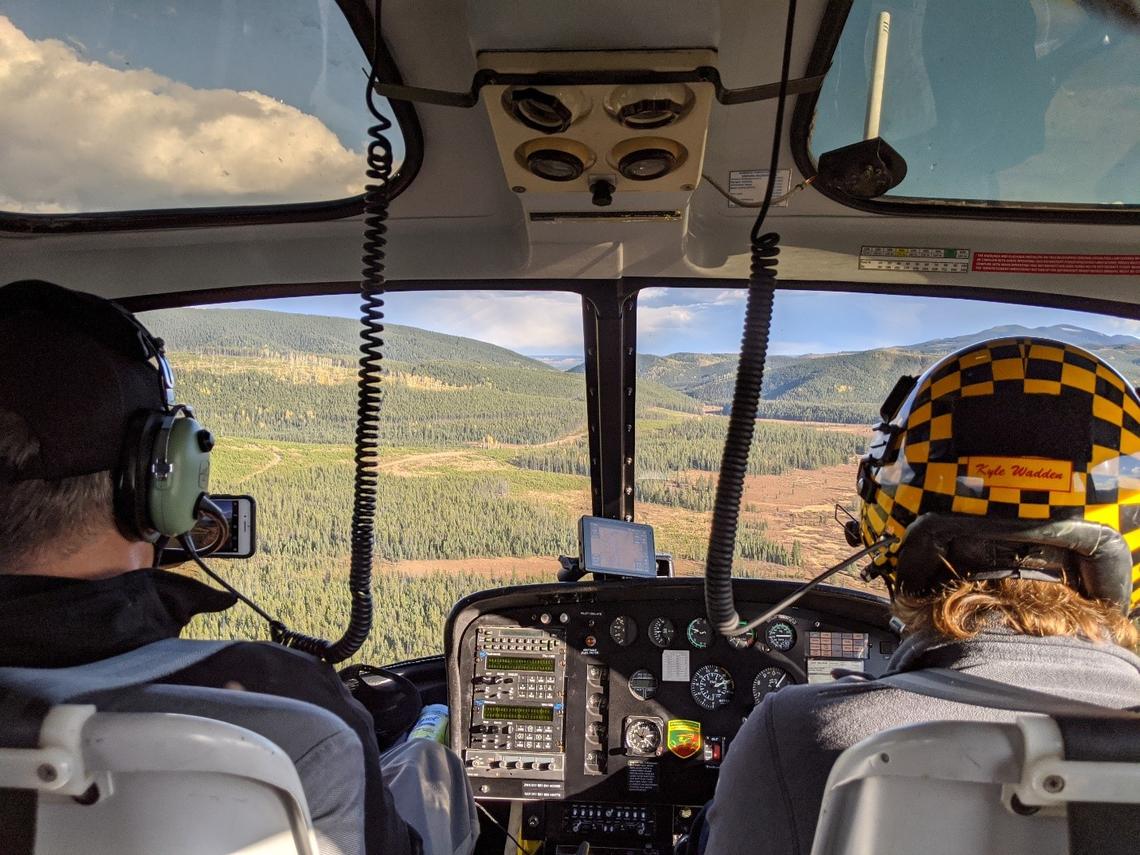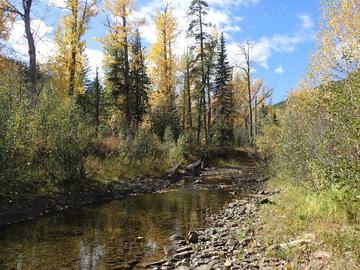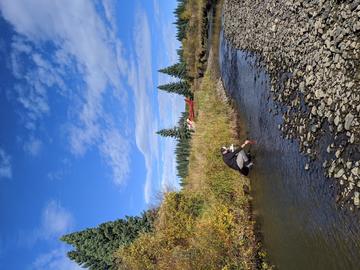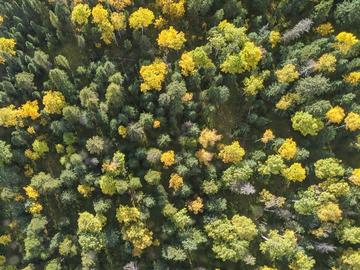Oct. 23, 2020
A bird's-eye view on saving the bull trout

In a clear, cold pool waits a patient predator, a monster of the river. He is voracious, ready to devour any prey which crosses his path, even if he has to fight for it. Many Alberta anglers can attest to his grit and have fond memories of wrestling with this feisty character. At the sight of his sleek, silvery-olive back and his orange speckled sides, they know this fish will not come quietly. He is the mighty bull trout.
The bull trout is Alberta’s provincial fish, and is world-renowned as an exciting fish for anglers even though it's catch-and-release only. People from all over the continent are attracted to Alberta’s waterways to battle the bull trout. But not all of them are here just for the thrill.
- Photo above: The helicopter waits as researchers collect samples and data at a site on the Tay River. Photo by Briana Van Den Bussche
Dr. Christie Sampson, PhD, is an Eyes High postdoctoral scholar in the lab of Dr. Steven Vamosi, PhD, a professor in UCalgary's Faculty of Science. Originally from Michigan, Sampson’s diverse research has taken her around the world — from tagging alligators in Florida to helping prevent elephant poaching in Myanmar to tracking tigers in Russia. Most recently, her passion for research and conservation led her to the Tay River here in Alberta, and to the bull trout, which is listed as threatened under Alberta’s Wildlife Act.
The Tay River is part of the Clearwater watershed, just west of Sundre, Alta., and is considered the frontline for battling the extirpation of bull trout in the entire watershed. “Bull trout haven’t yet given up on the Tay River, and we shouldn’t either,” says Jess Riley, fisheries biologist for Alberta Environment and Parks (AEP).
The Tay was chosen for a unique collaboration between University of Calgary researchers, Trout Unlimited Canada, Alberta Environment and Parks, the Alberta Riparian Habitat Management Society's Cows and Fish, and the Federal Department of Fisheries. The area is special as it rests at the base of the foothills, where the landscape is fragmented but not yet entirely farmland. It's also difficult to get to, so there's reduced pressure from anglers and other recreational users. But while the challenge of accessing this area is good for fish, it presents a challenge for researchers like Sampson.
Working with funding from the Department of Fisheries, and support from Trout Unlimited and Alberta Environment and Parks, Sampson was able to gain access to 16 remote sites along the Tay River using a helicopter. Her mission was to collect water samples from small tributaries and test them for the presence of eDNA (environmental DNA) to determine which tributaries might still have bull trout present. Sampson is collecting eDNA samples from rivers all around central and south Alberta. Once the samples are processed and it's determined where bull trout are, the data will be compared to a water temperature model developed by Alberta Environment and Parks.
Bull trout are quite picky about their habitat and require clean, clear, cold water, so climate change could be a big threat to this species. The water temperature model uses data from water loggers all over the province to determine which areas currently have suitably cold water. This is used in conjunction with information about land fragmentation and recreational use to determine which areas will continue to have cold water in the future and provide suitable bull trout habitat as the climate warms.
Sampson’s work with eDNA is validating this model by testing if the predicted sites actually have bull trout present. If the model is valid, Alberta Environment and Parks can use it to choose where to focus their habitat restoration and recovery efforts.

A glimpse at the fragmented landscape near the Tay River.
Briana Van Den Bussche
Sampson’s eDNA work may sound complicated but it’s actually a pretty basic idea. Every living thing leaves traces of DNA in its habitat. Things like feces, urine, skin cells and saliva all contain DNA which can be collected and tested. eDNA is primarily used in aquatic environments — water is great at keeping all those bits of DNA suspended — but there are some terrestrial applications, too. For example, tracking polar bears using the DNA found in skin cells or hairs left in their footprints on the snow.
For Sampson’s research, water samples are taken at each site. Back in the lab (a.k.a. her garage, due to the pandemic) the water is filtered through special cellulose nitrate membranes, which collect all the DNA from the samples. There's not only potential bull trout DNA in the samples, but also DNA from all the plants, fish, people, dogs, cows, etc. that may have come into contact with the water.
To separate out the bull trout DNA from the rest, Sampson and her collaborators will use a polymerase chain reaction (PCR) machine to copy and multiply any bits of bull trout DNA, so they can be detected using an assay specific to Alberta bull trout, developed by the Department of Fisheries. That way, even with just a trace of DNA, the samples can be tested for bull trout presence.
Once the areas with bull trout are identified, and the water temperature model is verified, work can begin right away on restoring and recovering habitat and conserving bull trout. This collaborative research project allows for almost immediate conservation actions to be taken, which is exciting for researchers, fish, anglers and everyday Albertans.
The bull trout's reputation as a fighting fish has earned it a place in the hearts of many Albertans and, as this project shows, it's a fish worth fighting for.
For more information about this project check out this Let’s Go Outdoors video, or read a recently published article in Nature.













